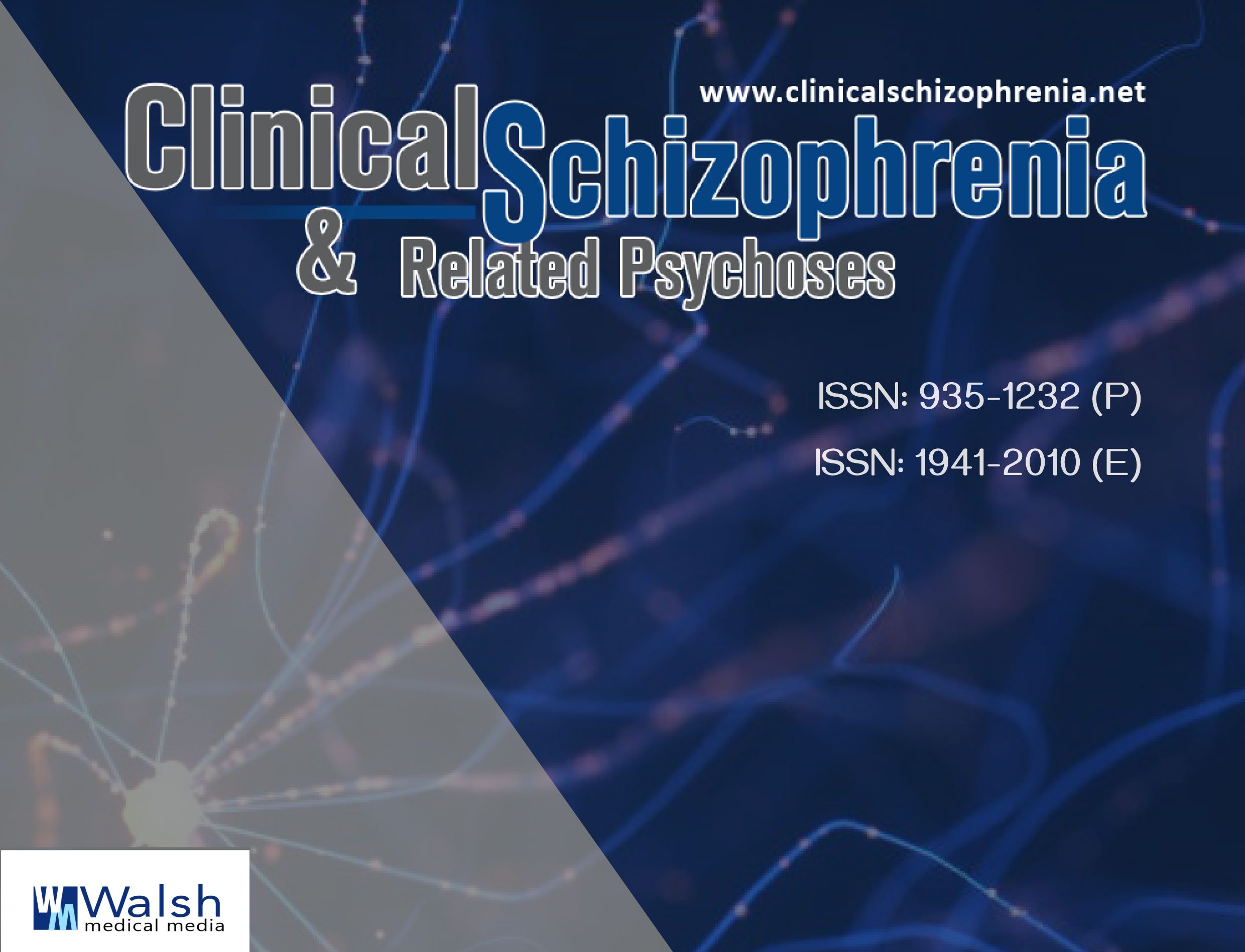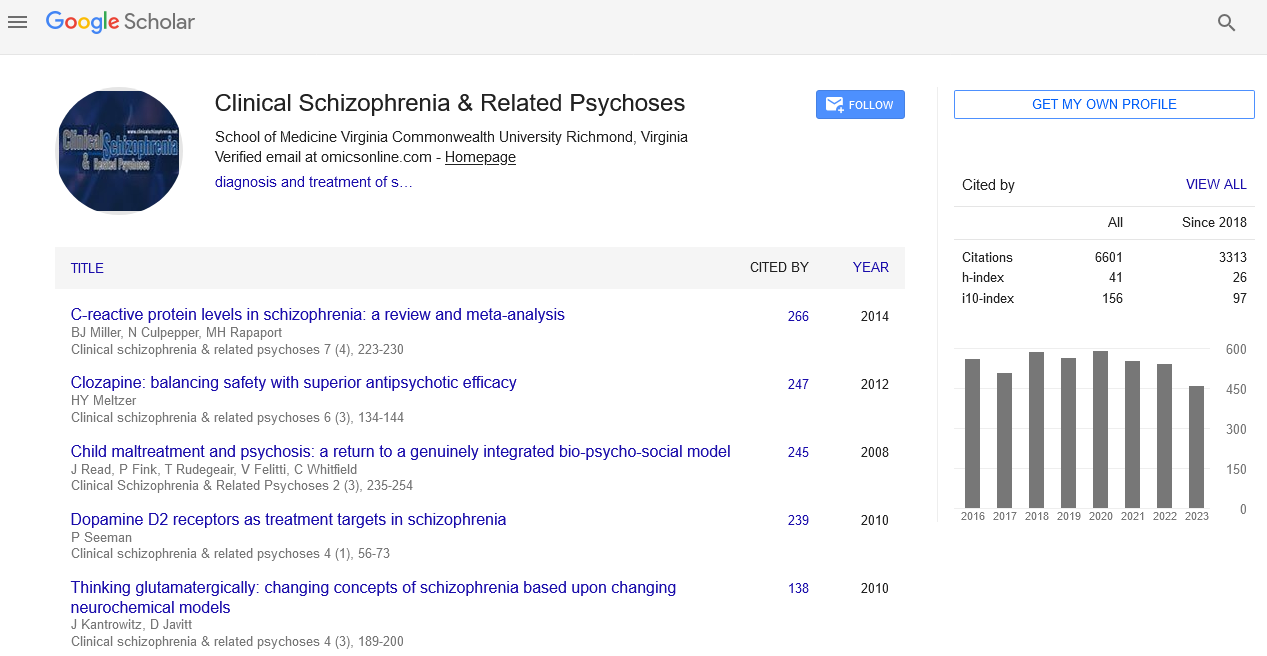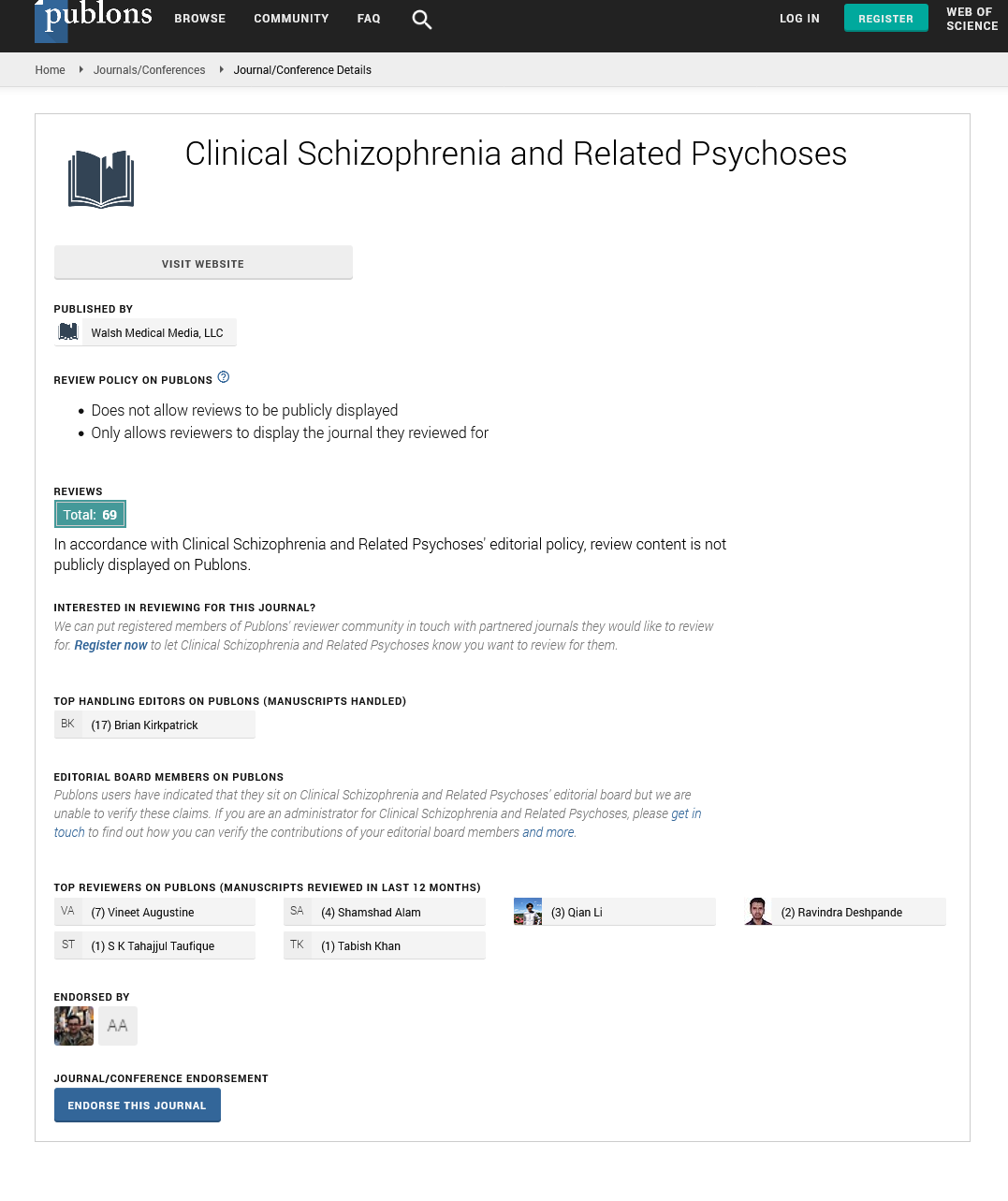Research Article - Clinical Schizophrenia & Related Psychoses ( 2022) Volume 16, Issue 2
A Patient with Delusional Misidentification: Declaring Generalized Amnesia
Igor J. Pietkiewicz1*, Radosław Tomalski1 and Anna Nowak-Bańbura22Department of Psychology, Psychology Institute, Jagiellonian University, Cracow, Poland
Igor J. Pietkiewicz, Department of Psychology, Research Centre for Trauma and Dissociation, SWPS University of Social Sciences and Humanities, Warsaw, Poland, Email: ipietkiewicz@swps.edu.pl
Received: 01-Jul-2022, Manuscript No. CSRP-22-68269; Editor assigned: 04-Jul-2022, Pre QC No. CSRP-22-68269 (PQ); Reviewed: 18-Jul-2022, QC No. CSRP-22-68269; Revised: 25-Jul-2022, Manuscript No. CSRP-22-68269 (R); Published: 03-Aug-2022, DOI: 10.3371/CSRP.PIRT.080322
Abstract
Background: Delusional misidentification is a psychotic symptom relating to misidentifying one’s own or someone else’s identity, objects, places, or events. Although rare cases of dissociative amnesia comorbid with psychotic episodes are discussed in literature, there are no such reports referring to the delusional misidentification syndrome.
Methods: This study describes a 42-year-old Polish female with a history of three hospitalizations for schizophrenia, during which she had problems with memory and was confused about her identity. She was subjected to clinical assessment using the Trauma and Dissociation Symptom Interview, and a mental state examination was performed by a psychiatrist.
Results: The participant reported generalized amnesia for identity and life history accompanied by the Capgras syndrome and reverse intermetamorphosis-like symptoms. She avoided discussing these symptoms, focusing instead on her somatic problems.
Discussion: This case illustrates an interaction between dissociative symptoms of amnesia, depersonalization/derealization, and psychotic symptoms in the formation of a delusional misidentification syndrome. It is important to explore in depth the dissociative symptomatology in patients with schizophrenia spectrum disorders.
Keywords
Capgras syndrome • Reverse intermetamorphosis • Delusional misidentification • Psychosis • Dissociative amnesia
Introduction
Delusional Misidentification Syndromes (DMS) are characterized by consistently misidentifying someone’s or one’s own identity, objects, places, or events [1]. They are represented by: Capgras syndrome-delusion that a close person is replaced by an identical impostor, Fregoli syndrome- delusion that different people are actually one person changing appearance, Syndrome of subjective doubles-delusion of having a clone with the same appearance, and Intermetamorphosis syndrome-delusion that another person is changing into someone else [2]. When the patient holds a belief of being transformed into another known person it is described as Reverse Intermetamorphosis (RI) [3,4]. Its subtype may be lycantrophy associated with the belief of becoming a werewolf. Some patients may have features of different DMS, or one type can evolve into another [5,6].
While ICD-11 has a separate diagnostic code, MB26.0B, for misidentification delusion [7], DMS are not coded in DSM-5. According to Jain, et al. authors of the American classification considered them rare and regarded as subtypes of the Delusional Disorder [8]. However, DMS have been found in many disorders, including schizophrenia spectrum disorders, bipolar disorders, depression, neurodegenerative disorders, and brain injuries [9,10].
Capgras Syndrome (CS), described in 1923 by Capgras and Reboul- Lachaux, is regarded as the most common form of DMS [11,12]. In the study of Salvatore, et al. it was present in 14.1% of 517 patients hospitalized for a first psychotic episode [2]. Patients with CS have a delusional conviction that one or more of their close friends or relatives has been replaced by a “double” that is identical to the original one. They do not dispute the extreme resemblance between these people but are convinced that they are in fact different [13]. CS can be transitory or become more permanent, evidently connected with the main disorder or independent of it [12].
Inability to recognize significant others and confusion about one’s own identity is also reported by patients with a diagnosis of dissociative amnesia (with or without fugue) and Dissociative Identity Disorder (DID), but the mechanisms behind those difficulties may differ. Diagnostic criteria for these disorders are presented in Table 1. In the case of dissociative amnesia, it can be a transitory or permanent reaction of some patients to stressful events, e.g., debt, marriage problems, death of loved ones [14,15]. In DID, on the other hand, when one dissociative identity is activated, it may have no access to the perspective and memories of another identity [16,17]. Switching into another dissociative identity can also lead to fugues or amnesia for daily events, qualitatively different from the ones discussed earlier [18]. Moreover, patients with DID often report a cluster of trauma- related symptoms which are not present in dissociative amnesia, e.g., symptoms of post-traumatic stress, auditory hallucinations, somatoform dissociation.
| ICD-11 | Dissociative amnesia without dissociative fugue 6B61.1 |
|
Dissociative amnesia is characterised by an inability to recall important autobiographical memories, typically of recent traumatic or stressful events that is inconsistent with ordinary forgetting. The amnesia does not occur exclusively during another dissociative disorder and is not better explained by another mental, behavioural or neurodevelopmental disorder. The amnesia is not due to the direct effects of a substance or medication on the central nervous system, including withdrawal effects, and is not due to a disease of the nervous system or to head trauma. The amnesia results in significant impairment in personal, family, social, educational, occupational or other important areas of functioning. |
|
|
Dissociative amnesia without dissociative fugue is characterised by all of the features of dissociative amnesia occurring in the absence of symptoms of dissociative fugue. |
|
| Additional clinical features | |
|
• In rare cases, amnesia may be generalized with regard to identity and life history. However, it is more commonly localized (i.e., failure to recall autobiographical events during a circumscribed period of time) or selective (i.e., failure to recall some but not all of the events during a circumscribed period of time). The extent of amnesia may vary over time. |
|
| Dissociative amnesia with dissociative fugue 6B61.0 | |
|
Dissociative amnesia with dissociative fugue is characterised by all of the features of Dissociative Amnesia, accompanied by dissociative fugue, i.e., a loss of a sense of personal identity and sudden travel away from home, work, or significant others for an extended period of time (days or weeks). A new identity may be assumed. |
|
| DSM-5 | Dissociative amnesia without dissociative fugue 300.12 |
|
A. An inability to recall important autobiographical information, usually of a traumatic or stressful nature, that is inconsistent with ordinary forgetting. Note: Dissociative amnesia most often consists of localized or selective amnesia for a specific event or events; or generalized amnesia for identity and life history. |
|
| Dissociative amnesia with dissociative fugue 300.13 | |
|
Apparently purposeful travel or bewildered wandering that is associated with amnesia for identity or for other important autobiographical information. |
This study presents a woman declaring generalized amnesia and delusional misidentification who registered for a clinical assessment, reporting symptoms suggestive of a dissociative amnesia, and expected to disconfirm her earlier diagnosis of schizophrenia.
Materials and Methods
This is a study of a female participant reporting generalized amnesia and revealing misidentification delusions characteristic of CS and reverse intermetamorphosis-like symptoms.
Procedure
This study is part of a larger project examining depersonalization and derealization in clinical and non-clinical groups, held at the Research Centre for Trauma and Dissociation, financed by the National Science Centre, and approved by the Ethical Review Board at the SWPS University of Social Sciences and Humanities. Potential candidates enrolled themselves via an application integrated with a dedicated website www.e-psyche.eu/trauma, or were registered by healthcare providers. They filled in demographic information and completed screening tests for dissociation: Dissociative Experiences Scale-Revised (DESR-PL) [19] and Somatoform Dissociation Questionnare (SDQ-20) [20]. This was followed by a semi-structured interview exploring their biography, family situation, and motives for enrolling in the study, a diagnostic consultation based on the Trauma and Dissociation Symptoms Interview (TADS-I), and a mental state assessment [21]. The TADS-I is a semi-structured interview, lasting about four hours, for the differential diagnosis of trauma-related symptoms according to DSM- 5 and ICD-11. The facts about her history collected from the participant during the assessment were also corroborated with a short interview with her mother.
Participant
Female, age 42, single, higher education, unemployed for the last two years and living with her parents. She was reluctant to talk about them. She had no friends and maintained very superficial relationships with her siblings who live abroad. Previously, she lived abroad for years and was financially independent, working as an au pair or a tutor for children with special needs. She did not report any traumatic experiences. She enrolled in the project to rule out schizophrenia, claiming that doctors were uncertain of this diagnosis and considered retrograde amnesia. She was also convinced that she had an undetected neurological disorder causing blinking. She obtained normal results in screening tests for dissociative disorders. Nevertheless, TADS-I was applied to explore in-depth her dissociative symptoms.
Data analysis
Qualitative data included clinical interviews and a mental state examination performed by a psychiatrist. All authors watched the interviews, read their transcripts carefully, and produced detailed notes about their content and clinically significant symptoms. They then discussed their notes and consensually determined the diagnosis. Due to the lack of compatible diagnostic criteria in the ICD-11 and DSM-5, the misidentification syndrome accompanying psychosis was established based on ICD-11.
Results
When the patient signed up for the project, she reported losing memory of her identity and history. During the interview she easily engaged herself in conversation, maintaining eye contact and good rapport. She presented no involuntary movements. Her affect was flattened, she denied having auditory hallucinations, thought broadcasting, or delusions of influence. She had very limited insight into experienced difficulties.
She said her difficulties started when she had a stressful time working abroad, which led to problems with sleep and eating regularly, depressed mood and disorientation. She also grew suspicious that people were dishonest and had bad intentions towards her. During three such episodes in the UK, France and USA (at age 30, 33 and 39), she was hospitalized, diagnosed with schizophrenia and subsequently treated with antipsychotic medication, with some improvement. Each time, during these episodes, she provided false names and biographical facts (about her birthplace, circumstances of her parents’ death), which she later justified with amnesia. Since her last hospitalization before enrolling in this study she remained uncertain about her identity. Each episode was preceded by feeling ill: “as if the body has lost control and immunity, very strong facial contractions, coughing and gagging”. In these moments, she sought help at a police station-she reported not knowing who she was, was convinced that her ID card contained false information, and wanted to establish her correct identity. During the last episode, she allegedly lost her documents, had generalized amnesia, and wanted to establish her identity at the police station. She believed that she had been assigned the identity and psychiatric history of another person who was missing at that time. She complained that the police had indiscriminately accepted testimonies of people claiming to be her relatives, but that they were de facto the family of the missing person who might have become a victim of human trafficking. She thought they were unable to accept the fact that the patient was not their daughter. After returning to Poland, she applied to the prosecutor’s office to establish her personal data which, in her opinion, were inconsistent with those in the documents. Her mother reported that her daughter addressed her impersonally and doubted if the mother was really who she claimed to be. During various episodes, she told different people that her parents had died in a car accident or in an apartment explosion. At the time of the interview, she was living with her parents and unable to maintain a job, which she attributed to her somatic symptoms.
During the interview she denied using alcohol or psychoactive substances. She did not declare any traumatic events fulfilling criterion for post-traumatic stress disorder, neither did she report symptoms of post- traumatic stress disorder (re-experiencing a traumatic event in the present, avoidance of trauma reminders and current sense of threat). She reported no problems with eating or sleeping, self-destructive behavior or problems with sexuality. At the time of the interview, she had no symptoms of anxiety but confirmed she had had them during previous episodes.
Depressive mood and generalized anxiety were limited to the aforementioned episodes of disorientation about her identity, but her mood was overall stable and balanced on a daily basis. She had positive self-esteem and described herself as: strong, diligent, and hardworking. She justified her inability to work in the past two years with neurological problems. She thought that ocular dystonia preceding her episodes led to the deterioration in her health, and memory problems. She said: “I had facial contractions and my eyes were blinking so fast that I was getting confused.”
She reports many physical complaints: Hashimoto’s disease, back pain, rheumatic pains, intestinal disorders, hemorrhoids, ocular dystonia. Each episode of her illness, according to the patient, was preceded by a “brain cough” - headache accompanied by vomiting reflexes and an intense cough. She reported occasional migraines in adulthood, which were accompanied by hypersensitivity to sounds, smells and light.
She denied having amnesia for normal, daily activities, but during her episodes was unable to recall facts from her life (studies, former work, or events reported by family members). During the interview she tried to avoid answering questions about her life history and identity. She said it did not bother her anymore because she was focused on her ocular dystonia which disorganized her functioning.
During the interview she reported no depersonalization or derealization.
She associated each of the three episodes with the experience of blockage or emptiness: "I had no memories as if I had no brain." Something seemed to be threatening her, but she was unable to tell what it was. She felt out of place, experienced the surroundings as unfamiliar, and had serious doubts about her identity: “It seemed to me that I had a different identity, and I wanted to check that. I thought the documents weren't mine, that the ID card had the wrong name on it. I suspected I may have been adopted." She did not exhibit any symptoms indicating the presence of alternative identities.
Discussion
The patient in this study reported symptoms characteristic of CS accompanied by delusional misidentification of her own identity. The latter resembles RI, however she did not report changing into someone else, but rather a delusional conviction that she had a different identity and produced false memories (e.g., about her parents’ death). She had persecutory delusions in the past and currently her functioning and thinking was disorganized. She had very limited insight into her difficulties. She presented no clusters of symptoms suggestive of DID, such as the existence of concurrent alternative identities or amnesia for current events.
The development of her symptoms shares some similarities to dissociative amnesia: she felt overwhelmed with problems at work, experienced depersonalization and derealization (blockage, emptiness, feeling out of place, experiencing the surroundings as unfamiliar), amnesia (no memories as if I had no brain), and confusion about her identity. Similar scenarios are described in case studies of dissociative amnesia [14,15]. Our patient first experienced amnesia of her personal identity and biography. Only later did she develop and maintain a new identity, trying to confirm it with the police. Creating new identities when the old one was covered with amnesia has been described by some authors Chadda, et al. and Staniloiu, et al. [22,23]. Moreover, our patient remained reluctant to explore her history by concentrating on her somatoform symptoms. While this may be characteristic of psychosis, it is worth emphasizing that similar avoidance is often reported in dissociative amnesia [16,17].
Depersonalization and derealization may be part of the onset of both amnesia and psychosis. Igwe mentions a patient whose dissociative amnesia with fugue was preceded with derealization (the whole room and objects becoming unstable and unreal) [24]. On the other hand, some authors observe that depersonalization and derealization often precede the onset of DMS [9,25]. Patients may then resort to delusional thinking, trying to make sense of their disconnection between feelings of unfamiliarity and face recognition. According to Ellis, et al. CS can involve a dysfunction of the pathway sustaining covert and affective face recognition, resulting in unfamiliarity and estrangement [26]. This may be due to structural damage or (perhaps) functional disconnection-depersonalization and derealization-supported by dissociative mechanisms. In their Cambridge depersonalization scale, Sierra, et al. included items corresponding to such experiences, for example: #18 out of the blue, I find myself not feeling any affection towards my family and close friends;#29 previously familiar places look unfamiliar, as if I had never seen them before [27]. Perhaps, the feeling of disconnection from past memories, expressed in item#16 I feel detached from memories of things that have happened to me-as if I had not been involved in them, may also contribute to amnesia. However, there is no systematic research on depersonalization/derealization and trauma history in patients with DMS. This could elucidate how the aforementioned disconnection can contribute to formation of delusions.
There is new research exploring pathways between life adversities and psychosis, showing that dissociation may be a mediating factor [28]. Depersonalization and derealization in psychosis have been explored so far to some extent. However, amnesia in the context of trauma and psychosis has not received sufficient attention.
It can be stipulated that this patient, being overwhelmed with stressful events or psychotic experiences, developed dissociative amnesia such as she declared initially. Because there was no doubt that she had delusional symptoms, the co-occurring symptoms of dissociative amnesia were easily attributed to her delusional thinking. While comorbid dissociative amnesia and schizophrenia are regarded as rare, clinicians should be aware of this possibility [29,30]. The tendency to dismiss dissociative symptoms when psychotic ones are present may be common in diagnosing patients with schizophrenia spectrum disorders. Exploration of dissociative symptomatology in psychotic patients presents challenges, because screening tools may not capture it adequately, and using in-depth interviews is necessary.
Conclusion
Clinicians focus solely on psychotic symptoms in patients with schizophrenia spectrum disorders and sometimes overlook the dissociative symptomatology that occurs. The relationship between the two psychopathologies is still not clear and requires further research. Some patients attempt to make sense of dissociative symptoms (depersonalization, derealization, and amnesia or somatoform dissociation) and resort to delusional thinking. Thus, in-depth examination of dissociative symptoms reported by patients in psychosis is encouraged.
Funding
This work was supported by the National Science Centre, Poland under Grant (number 2016/22/E/HS6/00306).
Disclosure
The authors report there are no competing interests to declare.
References
- Feinberg, Todd E. and David M. Roane. "Delusional Misidentification." Psychiatr Clin North Am 28 (2005): 665-83.
[Crossref] [Google scholar] [pubmed]
- Salvatore, Paola, Chaya Bhuvaneswar, Mauricio Tohen and Hari-Mandir K. Khalsa, et al. "Capgras' Syndrome in First-Episode Psychotic Disorders." Psychopathology 47 (2014): 261-9.
[Crossref] [Google scholar] [pubmed]
- Hanin, Bella, Meir Perlow, Natella Ben-Daniel and Shimshon Itzhaki. "Reverse Intermetamorphosis: A Rare Misidentification Phenomenon." Isr J Psychiatry Relat Sci 31 (1994): 296-9.
[Google scholar] [pubmed]
- Breen, Nora, Diana Caine and Max Coltheart. "Models of Face Recognition and Delusional Misidentification: A Critical Review." Cogn Neuropsychol 17 (2000): 55-71.
[Crossref] [Google scholar] [pubmed]
- Klein, Carolina A., and Soniya Hirachan. "The Masks of Identities: Who's Who? Delusional Misidentification Syndromes." J Am Acad Psychiatry Law 42 (2014): 369-78.
[Google scholar] [pubmed]
- Silva, Arturo and Gregory B. Leong. "Delusions of Psychological Change of the Self." Psychopathology 27 (1994): 285-90.
[Crossref] [Google scholar] [pubmed]
- World Health Organization. MB26.0B Misidentification Delusion. Geneva: World Health Organization, Switzerland, (2022).
- Jain, S.B., Shah, K. and Wadhwa, R. Capgras Syndrome. Florida: StatPearls Publishing, USA, (2021).
- Merrin, Edward L. and Peter M. Silberfarb. "The Capgras Phenomenon." Arch Gen Psychiatry 33 (1976): 965-8.
[Crossref] [Google scholar] [pubmed]
- Ventriglio, Antonio, Dinesh Bhugra, Domenico de Berardis and Julio Torales, et al. "Capgras and Fregoli Syndromes: Delusion and Misidentification." Int Rev Psychiatry 32 (2020): 391-5.
[Crossref] [Google scholar] [pubmed]
- Capgras, Joseph and Reboul-Lachaux J. "The Illusion of Doubles in a Chronic Systematic Delirium." Bull Soc Clin Med Ment 2 (1923): 6-16.
- Barrelle, Alain and J-P. Luauté. "Capgras Syndrome and Other Delusional Misidentification Syndromes." Front Neurol Neurosci 42 (2018): 35-43.
[Crossref] [Google scholar] [pubmed]
- Christodoulou, George N. "The Syndrome of Capgras." Br J Psychiatry 130 (1977): 556-64.
[Crossref] [Google scholar] [pubmed]
- Ishida, Mayumi, Hideki Onishi, Hiroaki Toyama and Chizuko Tsutsumi, et al. "Missing Memories of Death: Dissociative Amnesia in the Bereaved the Day after a Cancer Death." Palliat Support Care 13 (2015): 1787-90.
[Crossref] [Google scholar] [pubmed]
- Tripathi, Ravikesh, Srikala Bharath, Geetha Desai and Seema Mehrotra. "Therapist Concerns and Process Issues in Grappling with Functional Autobiographical Amnesia." Indian J Psychol Med 35 (2013): 305-8.
[Crossref] [Google scholar] [pubmed]
- Nijenhuis, Ellert RS and Onno van der Hart. "Dissociation in Trauma: A New Definition and Comparison with Previous Formulations." J Trauma Dissociation 12 (2011): 416-45.
[Crossref] [Google scholar] [pubmed]
- Van Der Hart, Onno and Ellert Nijenhuis. "Generalized Dissociative Amnesia: Episodic, Semantic and Procedural Memories Lost and Found." Aust N Z J Psychiatry 35 (2001): 589-600.
[Crossref] [Google scholar] [pubmed]
- Steele, K., Boon, S., and van der Hart, O. Treating Trauma-Related Dissociation. A Practical, Integrative Approach. New York: W. W. Norton and Company, USA, (2016).
- Pietkiewicz, Igor J., A. M. Hełka and R. Tomalski. "Validity and Reliability of the Revised Polish Online and Pen-and-Paper Versions of the Dissociative Experiences Scale (DESR-PL)." European J Trauma Dis 3 (2019): 235-43.
- Pietkiewicz, Igor J., Anna M. Helka and Radoslaw Tomalski. "Validity and Reliability of the Polish Online and Pen-and-Paper Versions of the Somatoform Dissociation Questionnaires (SDQ-20 and PSDQ-5)." European J Trauma Dis 3 (2019): 23-31.
- Boon, S., and Matthess, H. "Trauma and Dissociation Symptoms Interview (TADS-I)." ESTD, August 8, (2019).
- Chadda, R. K., N. Singh and D. Raheja. "Amnesia for Autobiographical Memory: A Case Series." Indian J Psychiatry 44 (2002): 283-8.
[Google scholar] [pubmed]
- Staniloiu, Angelica, Hans J. Markowitsch and Matthias Brand. "Psychogenic Amnesia–A Malady of the Constricted Self." Conscious Cogn 19 (2010): 778-801.
[Crossref] [Google scholar] [pubmed]
- Igwe, Monday N. "Dissociative Fugue Symptoms in a 28-year-old Male Nigerian Medical Student: A Case Report." J Med Case Rep 7 (2013): 1-3.
[Crossref] [Google scholar] [pubmed]
- Christodoulou, George N. "The Delusional Misidentification Syndromes." Br J Psychiatry Suppl 159 (1991): 65-69.
[Crossref] [Google scholar] [pubmed]
- Ellis, Hadyn D., Andrew W. Young, Angela H. Quayle and Karel W. De Pauw. "Reduced Autonomic Responses to Faces in Capgras Delusion." Proc Biol Sci 264 (1997): 1085-92.
[Crossref] [Google scholar] [pubmed]
- Sierra, Mauricio, Dawn Baker, Nicholas Medford and Anthony S. David. "Unpacking the Depersonalization Syndrome: An Exploratory Factor Analysis on the Cambridge Depersonalization Scale." Psychol Med 35 (2005): 1523-32.
[Crossref] [Google scholar] [pubmed]
- Alameda, Luis, Victoria Rodriguez, Ewan Carr and Monica Aas, et al. "A Systematic Review on Mediators between Adversity and Psychosis: Potential Targets for Treatment." Psychol Med 50 (2020): 1966-76.
[Crossref] [Google scholar] [pubmed]
- Agenagnew, Liyew, Elias Tesfaye, Selamawit Alemayehu and Mathewos Masane, et al. "Dissociative Amnesia with Dissociative Fugue and Psychosis: A Case Report from a 25-Year-Old Ethiopian Woman." Case Rep Psychiatry 2020 (2020): 1-7.
[Crossref] [Google scholar] [pubmed]
- Li, Keqing, William T. Yang and Alexander G. Perez. "Man of Mystery: A Case Report of Dissociative Amnesia in Schizophrenia." Cureus 13 (2021): e20688.
[Crossref] [Google scholar] [pubmed]
Citation: Pietkiewicz, Igor J., Radosław Tomalski and Anna Nowak-Bańbura. “A Patient with Delusional Misidentification: Declaring Generalized Amnesia.” Clin Schizophr Relat Psychoses 16 (2022). Doi: 10.3371/CSRP.PIRT.080322.
Copyright: © 2022 Pietkiewicz IJ, et al. This is an open-access article distributed under the terms of the Creative Commons Attribution License, which permits unrestricted use, distribution, and reproduction in any medium, provided the original author and source are credited. This is an open access article distributed under the terms of the Creative Commons Attribution License, which permits unrestricted use, distribution, and reproduction in any medium, provided the original work is properly cited.






